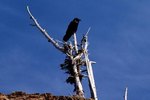
The great Philippine eagle (Pithecophaga jefferyi) is the world’s largest eagle, his wingspan 2 meters. The IUCN classifies this eagle as critically endangered, due in large part to widespread deforestation. One common name for this large bird is the monkey-eating eagle, so-called because his diet sometimes includes monkeys.
Diet
Philippine eagles were thought to feed solely on monkeys but have been found to feed largely on lemurs and palm civets -- nocturnal small mammals -- in addition to monkeys. These raptors consume a variety of other mammals, including rats, bats and flying squirrels living in the Philippines. Snakes, monitor lizards and other birds are also great Philippine eagle prey. Because these eagles live on four very different islands of the Philippines, their preferred prey differ. Mindanao eagles consuming more flying lemurs than other foods, for instance; but that animal doesn’t live on Luzon.
Hunting Habits
Philippine eagles hunt in pairs, using a decoy system to hunt prey. One eagle is the decoy, landing close to the prey -- such as on a nearby perch -- so the prey focus on him. The heretofore unseen other eagle swoops in, snagging a meal for the pair. These eagles also hunt individually, moving downhill while hunting from perches. Monkey-eating eagles live and hide in treetops, which is where they hunt and raise their young. Deforestation of their natural habitat has decreased their ability to effectively hide and hunt, namely because a breeding pair needs approximately 25 to 50 square miles of rain forest.
References
Photo Credits
-
Anup Shah/Photodisc/Getty Images
Writer Bio
Elizabeth Muirhead is a practicing veterinarian with an undergraduate degree in biological sciences. She has real-world experience with the husbandry, grooming, training and feeding a variety of household pets.



